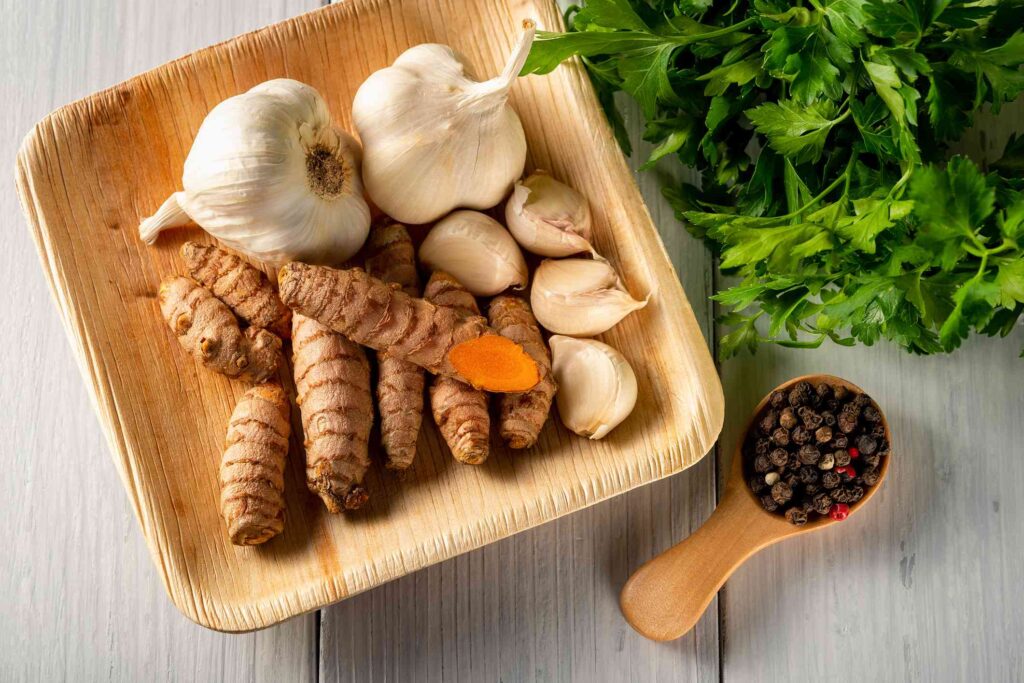:max_bytes(150000):strip_icc():format(jpeg)/Health-GettyImages-1362926591-c529f020a37d404a88c9d1997d33cf5b.jpg)
Garlic (Allium sativum) and turmeric (Curcuma longa) are common household ingredients best known for their potent flavors and many purported health benefits. While both are technically root vegetables, they’re often used as spices in cooking.
The flavorful ingredients boast an impressive profile of bioactive compounds that can support many areas of health. Research shows that turmeric and garlic have anti-inflammatory properties that can support immune health and reduce chronic disease risk.
Taking these spices together may compound their effects, providing cold and flu protection and supporting overall health.
Turmeric, a potent spice known for its golden-orange hue, has been a cornerstone of traditional Ayurvedic and Chinese medicine for centuries. It’s native to Southeast Asia and sourced from the rhizome or root of the Curcuma longa plant. Its active compound, curcumin, offers many potential health benefits.
- Chronic disease support: Curcumin may help protect the body against chronic (long-term) disease. Curcumin can help reduce inflammation, potentially improving symptoms related to inflammatory diseases, including arthritis, psoriasis, atherosclerosis, inflammatory bowel disease (IBD), and depression.
- Heart health: Turmeric may support heart health. Research has shown that curcumin can improve blood pressure and cholesterol levels and help maintain healthy blood vessel function.
- Brain health: Turmeric may also support brain health and cognitive function throughout the aging process. Curcumin’s anti-inflammatory and antioxidant properties may help protect against neurodegenerative diseases like Alzheimer’s disease (AD), dementia, Parkinson’s disease (PD), and multiple sclerosis (MS). These benefits may begin in the gut microbiota (living organisms like bacteria, fungi, and viruses in the gut).
- Gut health: Curcumin might help regulate the gut-brain axis. Research indicates that turmeric may improve digestion and reduce symptoms related to gastrointestinal (GI) diseases like irritable bowel syndrome (IBS) and ulcerative colitis (UC).
With its intense flavor and many health benefits, garlic is a staple in kitchens and traditional medicine worldwide. Though technically an edible root, garlic is considered a functional spice due to its significant nutrient profile. It contains high levels of potassium, phosphorous, zinc, and sulfur and many bioactive compounds like polyphenols, flavonoids, and tannins. Here are some possible benefits:
- Disease prevention: Garlic contains organo-sulfur compounds, which may reduce inflammatory markers and protect cells from oxidative damage. This may help combat chronic inflammation and reduce the risk of chronic diseases like heart disease and some cancers.
- Immune support: Garlic has been linked to antiviral activity, suggesting it may help protect the body against pathogens (disease-causing bacteria) that cause common illnesses like colds, respiratory infections, and the flu.
- Brain health: Consuming garlic may support brain health by protecting against cognitive decline.
- Liver support: More research is needed to understand its effects fully, but garlic may also reduce the risk of developing fatty liver disease in some people.
Turmeric and garlic are both known for their immune-boosting properties. The curcumin found in turmeric offers anti-inflammatory, antimicrobial, and antioxidant effects that can support a healthy immune response. Garlic’s anti-inflammatory and antiviral properties can also promote immune health.
Including turmeric and garlic in a well-balanced diet may improve overall health and support a strong immune system. One study suggests that taking garlic and turmeric together may enhance the spice’s immune-boosting effects, strengthening immune function and protecting against infections and chronic diseases.
More research is needed to better understand garlic and turmeric’s combined effects.
Both turmeric and garlic offer impressive health benefits and are available in many forms. You can consume either root as a food, spice, tea, or supplement. In these forms, take them together or separately. Below are various ways to enjoy turmeric and garlic with proper dosing.
Drink as a Tea
In tea form, turmeric and garlic create a soothing, nutrient-rich herbal tonic. You can purchase turmeric or garlic tea bags or use the root vegetables to make your own brew at home.
To make turmeric tea, simmer approximately one teaspoon of ground turmeric powder in hot water for several minutes. You can add ingredients like honey or black pepper to enhance its flavor and nutritional benefits.
To make garlic tea, crush 1-2 cloves of fresh garlic and steep them in hot water for several minutes. If desired, add honey and lemon for flavor.
To make a garlic and turmeric brew, boil both ingredients and let steep for several minutes. Strain if necessary, and add honey, lemon, or ginger for extra flavor and nutrition.
Use as a Cooking Spice
Along with their prominent health benefits, turmeric and garlic can enhance the flavor of many cuisines.
Turmeric, sometimes called Indian saffron, is often used in savory curries and soups. It can also be a nutritious addition to smoothies and marinades. A little goes a long way; you generally only need a teaspoon to enhance the taste of your meal.
Garlic is also a common ingredient in curry and pairs well with turmeric in savory dishes and marinades. You can consume garlic raw or cooked in various foods. Add it to pasta, soups, stews, chilis, sauces, salads, and dressings. Recommended portions will vary, but many recipes call for 1-2 raw cloves or 1-2 teaspoons of crushed garlic.
Take as a Supplement
Turmeric and garlic are available as supplements in powder, capsule, and tablet forms. Some multi-supplements include both, typically combined with other herbs or spices.
Curcumin supplements are available, but dosing varies between brands. More research is needed on the best dosage, but health experts recommend a daily intake of 0-3 milligrams of curcumin per kilogram of body weight. Taking turmeric with black pepper extract may enhance the bioavailability of curcumin, meaning your body absorbs more of the nutrients.
Garlic is also widely available in supplemental form, with many studies supporting the products’ health claims. Research has shown that doses ranging from 200-3,600 milligrams daily can provide distinct health benefits.
The presence of garlic’s beneficial compounds depends on the preparation method. Fresh garlic bulbs are rich in S-allyl-L-cysteine sulfoxide (alliin) and γ-glutamyl cysteine derivatives, while garlic powder contains alliin and diallyl disulfide (DADS).
Curcumin and alliin, the primary components of turmeric and garlic, are fat-soluble. Consider taking them with healthy fats like olive, coconut, or avocado oil, and ask your healthcare provider for dosing guidance.
While no one spice can be responsible for a healthy immune system, several herbs and spices have been linked to immune function. Examples of spices that may influence immunity include:
- Basil: Linked to antitumor, antioxidant, anti-inflammatory, antifungal, antiviral, and antibacterial properties
- Rosemary: Shown to have antitumor, antioxidant, and anti-inflammatory properties
- Sage: Linked to antitumor, antioxidant, anti-inflammatory, antimicrobial, antiviral, and antibacterial effect
- Thyme: Offers antitumor, antioxidant, anti-inflammatory, antimicrobial, antiviral, and antibacterial properties
- Oregano: Has antioxidant, anti-inflammatory, antimicrobial, antiviral, and antibacterial properties
- Ginger: Linked to anti-inflammatory, antimicrobial, antiviral, antibacterial, antitumor, and antiplatelet formation effects
- Cinnamon: Shown to have anti-inflammatory, antimicrobial, antiviral, antibacterial, antioxidant, antidiabetic, and antifungal properties
Turmeric and garlic are considered safe for the average healthy adult. Consuming them together may lead to greater health benefits, but you may experience more severe side effects.
Both turmeric and garlic can have blood-thinning effects, which may interact with blood-thinner medications like Coumadin (warfarin) and increase the risk of bleeding. The curcumin in turmeric and alliin in garlic can cause abnormal bleeding by inhibiting the production of the platelet-activating factor necessary for blood clotting.
People taking a blood thinner should exercise caution when consuming garlic or turmeric and discuss potential interactions with their healthcare provider.
Turmeric and garlic are generally well-tolerated when consumed in moderation or in the amounts typically found in food, but they may cause adverse side effects in some people.
Some people experience nausea and diarrhea after consuming a large amount of turmeric. Research has also linked turmeric intake to a potential risk of liver injury, but more evidence is needed to understand the extent.
Garlic may cause discomfort if consumed in excess. Eating large amounts of garlic may cause bloating, gas, and heartburn. You may also experience a change in body odor and bad breath.
Nutrition plays a crucial role in supporting immune function, and adding garlic and turmeric to your diet may enhance the body’s immune response. Science has linked the potent root vegetables, often used as herbs or spices, to many health benefits.
Both have anti-inflammatory properties, helping to reduce chronic inflammation and the associated risk of chronic disease. They can also help support heart health, cognitive function, and digestive health.
Garlic and turmeric are available as spices, teas, and supplements. Dosing will vary depending on your medical history, health goals, and tolerance level. Your healthcare provider can help you navigate these factors and safely incorporate garlic and turmeric into your routine.













